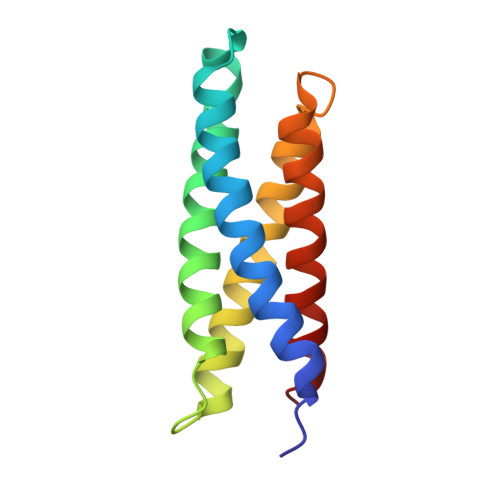A Histidine Residue and a Tetranuclear Cuprous-thiolate Cluster Dominate the Copper Loading Landscape of a Copper Storage Protein from Streptomyces lividans.
Straw, M.L., Hough, M.A., Wilson, M.T., Worrall, J.A.R.(2019) Chemistry 25: 10678-10688
- PubMed: 31111982
- DOI: https://doi.org/10.1002/chem.201901411
- Primary Citation of Related Structures:
6Q58, 6Q6B, 6QVH, 6QYB, 6R01 - PubMed Abstract:
The chemical basis for protecting organisms against the toxic effect imposed by excess cuprous ions is to constrain this through high-affinity binding sites that use cuprous-thiolate coordination chemistry. In bacteria, a family of cysteine rich four-helix bundle proteins utilise thiolate chemistry to bind up to 80 cuprous ions. These proteins have been termed copper storage proteins (Csp). The present study investigates cuprous ion loading to the Csp from Streptomyces lividans (SlCsp) using a combination of X-ray crystallography, site-directed mutagenesis and stopped-flow reaction kinetics with either aquatic cuprous ions or a chelating donor. We illustrate that at low cuprous ion concentrations, copper is loaded exclusively into an outer core region of SlCsp via one end of the four-helix bundle, facilitated by a set of three histidine residues. X-ray crystallography reveals the existence of polynuclear cuprous-thiolate clusters culminating in the assembly of a tetranuclear [Cu 4 (μ 2 -S-Cys) 4 (Ν δ1 -His)] cluster in the outer core. As more cuprous ions are loaded, the cysteine lined inner core of SlCsp fills with cuprous ions but in a fluxional and dynamic manner with no evidence for the assembly of further intermediate polynuclear cuprous-thiolate clusters as observed in the outer core. Using site-directed mutagenesis a key role for His107 in the efficient loading of cuprous ions from a donor is established. A model of copper loading to SlCsp is proposed and discussed.
- School of Biological Sciences, University of Essex, Wivenhoe Park, Colchester, CO4 3SQ, UK.
Organizational Affiliation:

















